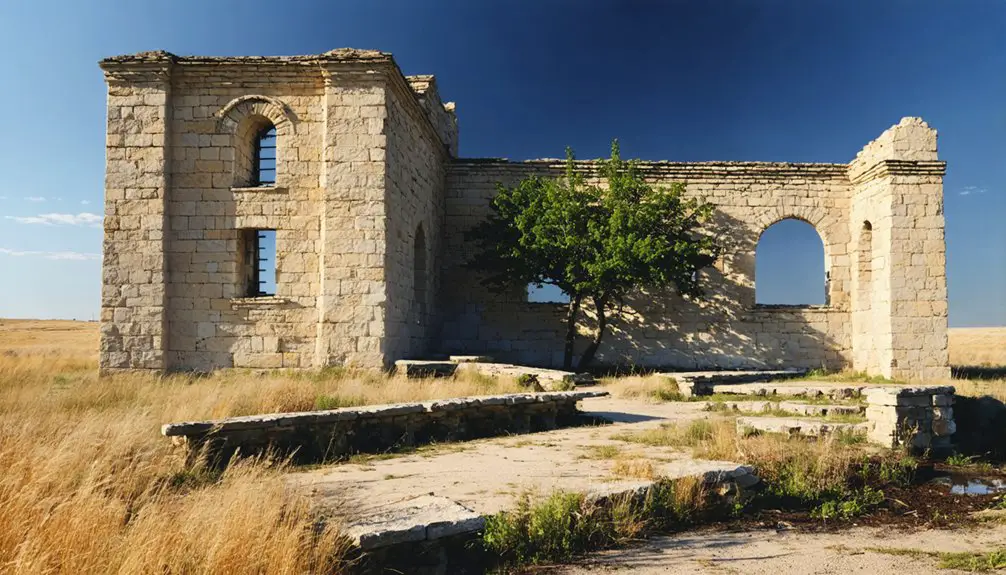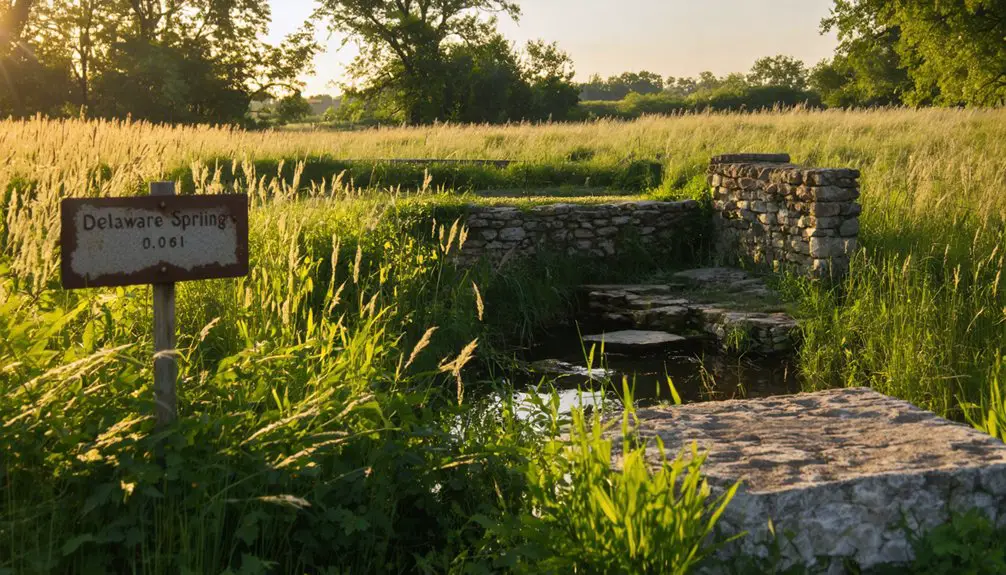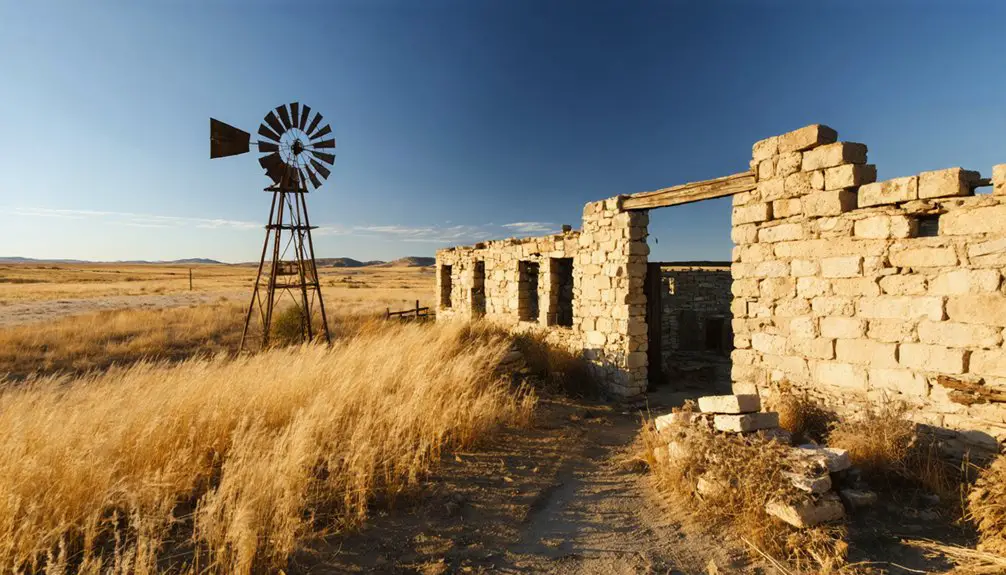You’ll find Delaware Springs among Kansas’ most historically significant ghost towns, established in 1854 along the Missouri River in Leavenworth County. The town began as Delaware City, founded by settlers from Platte County, Missouri, including L.F. Hollingsworth and George Quinby. Despite winning the county seat in 1855 and developing religious institutions like the first cathedral west of the Missouri River, the settlement’s isolation and lack of railroad connections led to its eventual decline. The site’s rich archaeological findings continue to reveal frontier life’s untold stories.
Key Takeaways
- Delaware City (later Delaware Springs) was established in 1854 but failed to thrive due to transportation limitations and lack of railroad connections.
- The town’s isolation and economic challenges led to its decline as nearby Leavenworth attracted more commerce and settlers.
- Despite winning the county seat battle in 1855, the town gradually lost population and commercial significance to better-connected neighboring communities.
- Archaeological surveys now cover 500 acres of the former settlement, preserving evidence of its brief but significant pioneering history.
- The site retains historical importance through its early religious institutions, including the first cathedral west of the Missouri River built in 1851.
Origins and Settlement in Leavenworth County
While the bustling city of Leavenworth would eventually dominate Kansas’s northeastern frontier, Delaware City emerged as its first serious rival in the summer of 1854. Settlers from Platte County, Missouri, including L.F. Hollingsworth and George Quinby, established this ambitious settlement along the Missouri River’s trading routes.
The town company, led by president S.B. Prentiss, quickly organized to promote growth and development. The initial town site encompassed 320 acres which was rapidly platted for development.
Settlement patterns in Delaware City reflected the dramatic changes released by the Kansas-Nebraska Act, as pioneers sought their fortunes in the newly opened territories. The ensuing county seat battle against Kickapoo City in 1855 resulted in Delaware City’s victory through legal contest.
You’ll find that Delaware City’s strategic location near Fort Leavenworth and its early establishment of a post office in 1856 initially promised great success.
The area’s rich heritage included Native American territories and an Indian mission, adding cultural depth to this frontier settlement.
The Pioneer Families Behind Delaware City
You’ll find Delaware City’s pioneering spirit embodied in L.F. Hollingsworth, who led a group of enterprising settlers from Platte County, Missouri, to establish this ambitious Kansas Territory settlement in 1854.
The town company, organized under president S.B. Prentiss, attracted prominent families like the Churchills, Fosters, and Chief Justice S.D. Lecompte, who saw potential in the 320-acre plat along the Missouri River corridor. Like many Kansas communities that emerged during the territory’s early development, Delaware City became a vital stop along the emigrant routes westward.
Together with George Quinby, William H. Spratt, and James Bruce, these early settlers worked to transform Delaware City into a formidable rival to neighboring Leavenworth, though their dreams would ultimately fade into ghost town history. Like many settlements of that era, Delaware City faced intense conflicts between pro-slavery and abolitionists that shaped its early development.
Early Settlement Leaders
A group of six pioneering families laid the foundation for Delaware City, Kansas in the summer of 1854, with L.F. Hollingsworth leading the charge alongside George Quinby and William H. Spratt.
These settlement leaders quickly organized a town company under S. B. Prentiss’s presidency, demonstrating their commitment to structured development.
Similar to many frontier settlements of the era, the town’s fate was heavily influenced by its railroad access and transportation links.
James Bruce, J. M. Churchill, and C. C. Redmon rounded out the core group of founders who made significant community contributions.
Together, they platted 320 acres for development and established the framework for what would become a prosperous frontier town.
Their vision culminated in the establishment of a post office by 1856, while their support of religious institutions, including the Sisters of Charity’s educational initiatives, helped shape Delaware City’s early cultural landscape.
Like Delaware’s first settlement of Zanel in 1631, these pioneers understood the importance of establishing strong trade relationships with local Native American communities.
Hollingsworth Family’s Town Vision
Long before L.F. Hollingsworth envisioned Delaware Springs, his ancestors had established a remarkable legacy of community building.
You’ll find the Hollingsworth family’s settlement aspirations deeply rooted in their history of developing thriving communities, from their noble beginnings at Hollynworthe Hall in England to their pioneering settlements in colonial Delaware.
The Hollingsworth legacy of leadership, which included serving in colonial assemblies, establishing religious meeting places, and managing vast landholdings, shaped their approach to town development. Valentine Hollingsworth Sr. exemplified this tradition when he received nearly 1,000 acres from William Penn in 1682.
Their vision consistently emphasized strong local governance, religious freedom, and sustainable land management. As a testament to their commitment to religious freedom, Valentine established a Friends meeting at his house shortly after arrival.
These principles, first demonstrated in their Delaware and Pennsylvania settlements of the 1680s, carried through generations as family members expanded westward, influencing their plans for new communities like Delaware Springs.
Missouri to Kansas Migration
During the mid-1800s, Missouri’s strategic river ports established themselves as essential launching points for pioneer families venturing into Kansas Territory. You’d find these determined settlers departing from bustling hubs like Independence, St. Joseph, and Old Franklin, where steamboats delivered vital supplies and provisions for the challenging westward journey. Wakarusa River banks required extensive shovel work to create safe crossing points for wagon trains.
As families crossed into Kansas, they faced significant migration challenges across the territory’s vast plains. They’d follow established trail routes like the Santa Fe Trail and its Cimarron Cutoff, often traveling in wagon trains pulled by sturdy oxen or mules. The Santa Fe Trail merchants traveled together in caravans to protect themselves from attacks during their journey.
These pioneers strategically planned their routes along waterways, carefully steering between supply points while battling scarce resources and harsh terrain. The network of trails branching from Missouri’s river ports created natural pathways for settling new communities, including emerging towns like Delaware City.
Religious Foundations and Educational Growth
In Delaware Springs’ early days, you’ll find Catholic priests establishing an Indian mission in 1848, which predated the town’s official platting by six years.
You can trace the area’s religious significance to 1851 when Bishop John Baptist Miège, S.J. built the first cathedral west of the Missouri River, known locally as the “log cathedral.”
You’ll see education taking root as the Jesuits transformed their mission into a boys’ boarding school after the Potawatomi departed, followed by the Sisters of Charity’s establishment of St. Mary’s Institute in 1859.
Catholic Mission Origins
Catholic missionaries played a transformative role in shaping Delaware Springs‘ early religious landscape, establishing one of 133 mission stations that dotted Kansas Territory between 1847-1883.
You’ll find that Delaware Springs emerged from humble beginnings as a Jesuit mission serving both Native American tribes and incoming settlers through missionary outreach and indigenous education programs.
- The mission station initially operated from private homes before expanding into dedicated church and school facilities.
- Jesuit priests provided both religious instruction and practical education, later evolving their facilities into a boys’ boarding school.
- The mission served as an essential bridge between tribal communities and settlers, fostering social cohesion through shared religious institutions.
This spiritual foundation would shape Delaware Springs’ development as both a religious and educational center in early Kansas Territory.
First Cathedral’s Establishment
When fire claimed the first structure in 1844, community involvement rallied to rebuild using black walnut framing and specially ordered shingles from St. Louis.
After a devastating tornado in 1886, the town’s determination manifested in a grand stone memorial church featuring pioneer missionary windows.
The final incarnation emerged in 1906: a $12,000 native stone cathedral, funded through local contributions and Methodist Episcopal support, standing as a tribute to Delaware Springs’ enduring faith.
Educational Institutes Emerge
Several pioneering educational institutions emerged in Delaware Springs during the mid-19th century, with St. Mary’s Institute leading the way. Established by the Sisters of Charity in 1859, this remarkable institution showcased architectural significance through its extensive facilities, including dormitories, study halls, and specialized rooms for music and drawing.
You’ll find the educational legacy of Delaware Springs deeply rooted in its religious foundations, as evidenced by the Catholic church’s influence and the missionary work of the Sisters of Charity.
- The institute’s strategic location on an elevation offered stunning views of Leavenworth and the Missouri River, creating an ideal learning environment.
- The property maintained its own post office named Xavier, Kansas, highlighting its prominence in the region.
- The institution’s transformation into the University of Saint Mary marked its evolution from a women’s school to a coeducational facility.
Economic Rise and Transportation Challenges
Despite its promising beginnings in 1854, Delaware Springs faced a critical turning point in its development due to transportation challenges that would ultimately seal its fate.
While early settlers established a thriving agricultural economy across 320 acres of fertile plains, severe transportation bottlenecks prevented the town from reaching larger markets.
You’ll find that the absence of railroad connections proved especially devastating, as nearby towns like Leavenworth secured essential rail links that diverted commerce and settlers away from Delaware Springs.
The resulting economic isolation forced local farmers to rely solely on limited regional trade, while competing towns flourished with modern transportation infrastructure.
The Role of Native American Missions

The Delaware Mission, established in 1832 near a spring grove in present-day Wyandotte County, Kansas, marked a significant chapter in Delaware Springs’ early history.
Under Reverend William Johnson‘s leadership, the mission’s missionary impact extended beyond religious conversion, serving as a crucial hub for education and cultural exchange.
You’ll find the mission’s influence shaped tribal relations through:
- Educational programs teaching farming and domestic skills to Delaware children
- Religious camp meetings that brought multiple tribes together with translation help from the Ketchum brothers
- Support for government “civilization” policies while maneuvering complex relationships between tribes and authorities
The mission’s 40×60 foot black walnut church stood as a symbol of Methodist determination until 1886, when a tornado destroyed it.
Today, a stone memorial church marks this significant site of cultural intersection.
From Thriving Town to Absorption by Leavenworth
While Delaware City emerged as a promising settlement in 1854 under the leadership of L.F. Hollingsworth and George Quinby, you’ll find its initial success was short-lived. The 320-acre community thrived briefly, boasting a post office by 1856 and hosting important institutions like a boys’ boarding school and the precursor to St. Mary’s Academy.
However, you can trace the community’s decline to Leavenworth’s strategic advantages. With Fort Leavenworth’s military presence and superior transportation infrastructure, businesses and residents gradually shifted away from Delaware City.
The historical legacy of this once-vibrant town lives on through its early Catholic mission and log cathedral, dating to 1848 and 1851. By the late 19th century, Delaware Springs had been completely absorbed into Leavenworth’s expanding city limits, marking the end of its independent existence.
Archaeological and Historical Significance Today

Modern archaeological investigations have revealed Delaware Springs‘ rich historical significance through systematic surveys covering 500 acres of high-probability landforms.
Today’s archaeological findings employ ground-penetrating radar and GIS technology to map cultural features while protecting sensitive areas, especially around Wilson’s Cemetery.
Cultural preservation efforts highlight three key aspects:
- Non-invasive research techniques that protect burial sites while documenting Delaware Indian settlement patterns
- Integration of historical records with archaeological data to reconstruct early 1800s tribal life
- Collaborative partnerships with Indigenous groups to guarantee respectful site management
You’ll find Delaware Springs’ importance reflected in ongoing National Register of Historic Places nominations, which recognize this landscape’s role in Kansas’ Native American heritage despite historical losses to agriculture and development.
Frequently Asked Questions
What Natural Disasters, if Any, Contributed to Delaware City’s Decline?
You won’t find direct evidence of natural calamities causing Delaware City’s decline, though Kansas towns commonly faced economic downturns from droughts and floods. The Dust Bowl’s impact remains possible but unconfirmed.
Are There Any Remaining Grave Sites or Cemeteries From Delaware City?
You won’t find any confirmed grave sites today, despite likely cemetery locations in the 1850s town. Grave site exploration hasn’t yielded documented remains, and no cemetery preservation efforts specifically track Delaware City burials.
What Was the Peak Population of Delaware City Before Decline?
Like an old Instagram post lost to time, you’d be interested to know Delaware City’s peak population remains unrecorded, though regional patterns suggest it likely reached between 200-1,000 residents during its historical significance.
Did Any Famous Historical Figures Ever Visit Delaware City?
You won’t find records of famous visitors to Delaware City, except for Bishop John Baptist Miège who established the first cathedral there. The town’s historical significance centered on religious missions rather than celebrity visits.
What Happened to the Original Land Deeds of Delaware City?
Picture dusty records scattered to the wind – you won’t find Delaware City’s original land deeds today. They’ve vanished with time, likely lost when land ownership shifted and deed transfers went undocumented during the town’s decline.
References
- https://esirc.emporia.edu/bitstream/handle/123456789/1577/McQuin Vol 8 Num 3.pdf
- https://legendsofkansas.com/delaware-city-kansas/
- https://en.wikipedia.org/wiki/Delaware_City
- https://www.youtube.com/watch?v=OyBXD18P_j4
- https://freepages.rootsweb.com/~gtusa/history/usa/ks.htm
- https://www.legendsofamerica.com/ks-leavenworth/
- https://www.kancoll.org/books/cutler/leavenworth/leavenworth-co-p33.html
- https://www.leavenworthks.gov/visitors/page/historic-leavenworth
- https://lostkansas.ccrsdigitalprojects.com/sites/lostkansas/files/private_static/2022-12/LT_LV_Kickapoo_Baker.pdf
- https://dianastaresinicdeane.wordpress.com/tag/ghost-towns/



